
Nuclear weapon designs are physical, chemical, and engineering arrangements that cause the physics package of a nuclear weapon to detonate. There are three existing basic design types:

Operation Castle was a United States series of high-yield (high-energy) nuclear tests by Joint Task Force 7 (JTF-7) at Bikini Atoll beginning in March 1954. It followed Operation Upshot–Knothole and preceded Operation Teapot.

Yellow Sun was the first British operational high-yield strategic nuclear weapon warhead. The name refers only to the outer casing; the warhead was known as "Green Grass" in Yellow Sun Mk.1 and "Red Snow" in Yellow Sun Mk.2.

Castle Bravo was the first in a series of high-yield thermonuclear weapon design tests conducted by the United States at Bikini Atoll, Marshall Islands, as part of Operation Castle. Detonated on March 1, 1954, the device was the most powerful nuclear device detonated by the United States and the first lithium deuteride-fueled thermonuclear weapon ever tested using the Teller-Ulam design. Castle Bravo's yield was 15 megatonnes of TNT (63 PJ), 2.5 times the predicted 6 megatonnes of TNT (25 PJ), due to unforeseen additional reactions involving lithium-7, which led to radioactive contamination in the surrounding area.
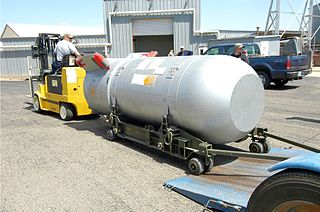
The Mk/B53 was a high-yield bunker buster thermonuclear weapon developed by the United States during the Cold War. Deployed on Strategic Air Command bombers, the B53, with a yield of 9 megatons, was the most powerful weapon in the U.S. nuclear arsenal after the last B41 nuclear bombs were retired in 1976.
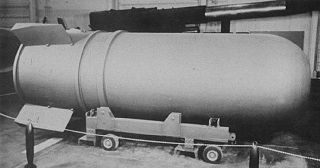
The B-41 was a thermonuclear weapon deployed by the United States Strategic Air Command in the early 1960s. It was the most powerful nuclear bomb ever developed by the United States, with a maximum yield of 25 megatons of TNT. A top secret document, states “The US has stockpiled bombs of 9 MT and 23 MT...” which would likely be referring to the B-41's actual yield(s). The B-41 was the only three-stage thermonuclear weapon fielded by the U.S.

Castle Yankee was the code name given to one of the tests in the Operation Castle series of American tests of thermonuclear bombs. It was originally intended as a test of a TX-16/EC-16 Jughead bomb, but the design became obsolete after the Castle Bravo test was successful. The test device was replaced with a TX-24/EC-24 Runt II bomb which was detonated on May 5, 1954, at Bikini Atoll. It released energy equivalent to 13.5 megatons of TNT, the second-largest yield ever in a U.S. fusion weapon test.

Castle Romeo was the code name given to one of the tests in the Operation Castle series of U.S. nuclear tests. It was the first test of the TX-17 thermonuclear weapon, the first deployed thermonuclear bomb.
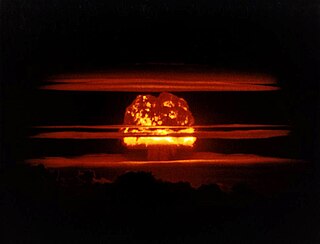
Castle Union was the code name given to one of the tests in the Operation Castle series of United States nuclear tests. It was the first test of the TX-14 thermonuclear weapon, one of the first deployed U.S. thermonuclear bombs.
The B46 nuclear bomb was an American high-yield thermonuclear bomb which was designed and tested in the late 1950s. It was never deployed. Though originally intended to be a production design, the B46 ended up being only an intermediate prototype of the B-53 and was test fired several times. These prototypes were known as TX-46 units (Test/Experimental).

The Mark 15 nuclear bomb, or Mk-15, was a 1950s American thermonuclear bomb, the first relatively lightweight thermonuclear bomb created by the United States.
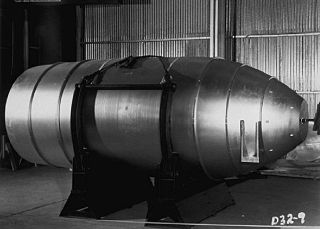
The Mark 14 nuclear bomb was a 1950s strategic thermonuclear weapon, the first deployed solid-fuel hydrogen bomb. It was an experimental design, and only five units were produced in early 1954. It was tested in April 1954 during the Castle Union nuclear test and had a yield of 6.9 Mt. The bomb is often listed as the TX-14 or EC-14. It has also been referred to as the "Alarm Clock" device though it has nothing to do with the design by the same name proposed earlier by Edward Teller and known as the Sloika in the Soviet Union.
Violet Club was a nuclear weapon deployed by the United Kingdom during the Cold War. It was Britain's first operational "high-yield" weapon and was intended to provide an emergency capability until a thermonuclear weapon could be developed from the 1956–1958 Operation Grapple tests. Violet Club was ultimately replaced in service by the Red Snow warhead, derived from the US W28 warhead.
The Mark 16 nuclear bomb was a large thermonuclear bomb, based on the design of the Ivy Mike, the first thermonuclear device ever test fired. The Mark 16 is more properly designated TX-16/EC-16 as it only existed in Experimental/Emergency Capability (EC) versions.

Orange Herald was a British nuclear weapon, tested on 31 May 1957. At the time it was reported as an H-bomb, although in fact it was a large boosted fission weapon and remains to date, the largest fission device ever detonated.

The Mark 17 and Mark 24 were the first mass-produced hydrogen bombs deployed by the United States. The two differed in their "primary" stages. They entered service in 1954, and were phased out by 1957.

The Mark 21 nuclear bomb was a United States thermonuclear gravity bomb first produced in 1955. It was based on the TX 21 "Shrimp" prototype that had been detonated during the Castle Bravo test in March 1954. While most of the Operation Castle tests were intended to evaluate weapons intended for immediate stockpile, or which were already available for use as part of the Emergency Capability Program, Castle Bravo was intended to test a design which would drastically reduce the size and costs of the first generation of air-droppable atomic weapons.

The uranium hydride bomb was a variant design of the atomic bomb first suggested by Robert Oppenheimer in 1939 and advocated and tested by Edward Teller. It used deuterium, an isotope of hydrogen, as a neutron moderator in a uranium-deuterium ceramic compact. Unlike all other fission-based weapon types, the concept relies on a chain reaction of slow nuclear fission. Bomb efficiency was adversely affected by the cooling of neutrons since the latter delays the reaction, as delineated by Rob Serber in his 1992 extension of the original Los Alamos Primer.
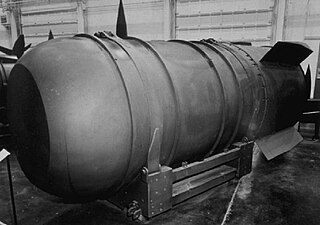
The Mk 36 was a heavy high-yield nuclear bomb designed in the 1950s. It was a thermonuclear, using a multi-stage fusion secondary system to generate yields up to about 10 megatons TNT equivalent.















